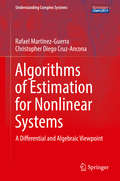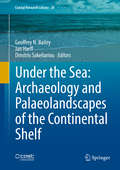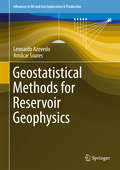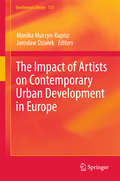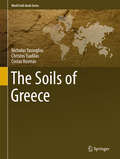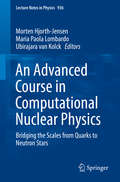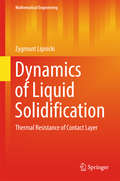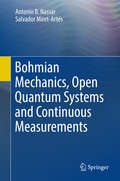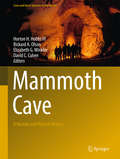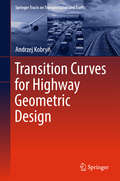- Table View
- List View
Lagrangian Oceanography: Large-scale Transport and Mixing in the Ocean (Physics of Earth and Space Environments)
by Sergey V. Prants Michael Yu. Uleysky Maxim V. BudyanskyThis book uses the Lagrangian approach, especially useful and convenient for studying large-scale transport and mixing in the ocean, to present a detailed view of ocean circulation. This approach focuses on simulations and on monitoring the trajectories of fluid particles, which are governed by advection equations. The first chapter of the book is devoted to dynamical systems theory methods, which provide the framework, methodology and key concepts for the Lagrangian approach. The book then moves on to an analysis of chaotic mixing and cross-stream transport in idealized models of oceanic meandering currents like the Gulfstream in the Atlantic, the Kuroshio in the Pacific, and Antarctic Circumpolar Current, after which the current state of physical oceanography is reviewed. The latter half of the book applies the techniques and methods already described in order to study eddies, currents, fronts and large-scale mixing and transport in the Far-Eastern seas and the north-western part of the Pacific Ocean. Finally, the book concludes with a discussion of Lagrangian simulation and monitoring of water contamination after the Fukushima disaster of 2011. The propagation of Fukushima-derived radionuclides, surface transport across the Kuroshio Extension current, and the role of mesoscale eddies in the transport of Fukushima-derived cesium isotopes in the ocean are examined, and a comparison of simulation results with actual measurements are presented.Written by some of the world leaders in the application of Lagrangian methods in oceanography, this title will be of benefit to the oceanographic community by presenting the necessary background of the Lagrangian approach in an accessible manner.
Algorithms of Estimation for Nonlinear Systems: A Differential and Algebraic Viewpoint (Understanding Complex Systems)
by Rafael Martínez-Guerra Christopher Diego Cruz-AnconaThis book acquaints readers with recent developments in dynamical systems theory and its applications, with a strong focus on the control and estimation of nonlinear systems. Several algorithms are proposed and worked out for a set of model systems, in particular so-called input-affine or bilinear systems, which can serve to approximate a wide class of nonlinear control systems. These can either take the form of state space models or be represented by an input-output equation. The approach taken here further highlights the role of modern mathematical and conceptual tools, including differential algebraic theory, observer design for nonlinear systems and generalized canonical forms.
Mycorrhiza - Function, Diversity, State of the Art
by Ajit Varma Ram Prasad Narendra TutejaThis is the fourth updated and revised edition of a well-received book that emphasises on fungal diversity, plant productivity and sustainability. It contains new chapters written by leading experts in the field.This book is an up-to-date overview of current progress in mycorrhiza and association with plant productivity and environmental sustainability. The result is a must hands-on guide, ideally suited for agri-biotechnology, soil biology, fungal biology including mycorrrhiza and stress management, academia and researchers. The topic of this book is particularly relevant to researchers involved in mycorrhiza, especially to food security and environmental protection. Mycorrhizas are symbioses between fungi and the roots of higher plants. As more than 90% of all known species of plants have the potential to form mycorrhizal associations, the productivity and species composition and the diversity of natural ecosystems are frequently dependent upon the presence and activity of mycorrhizas. The biotechnological application of mycorrhizas is expected to promote the production of food while maintaining ecologically and economically sustainable production systems.
GIS and Environmental Monitoring: Applications in the Marine, Atmospheric and Geomagnetic Fields (Geotechnologies and the Environment #20)
by Stavros Kolios Andrei V. Vorobev Gulnara R. Vorobeva Chrysostomos StyliosThis book constitutes a notable contribution to investigate and present the capabilities of Geographic Information Systems (GIS) and their applicability and usefulness in environmental-related applications and sciences. The focus is on the design, creation, development and operation of integrated Web-based GIS applications for weather, marine and atmospheric environments, and the Earth's magnetic field. More specifically, the aim of this book is to present characteristic applications of GIS to environmental monitoring including GIS solutions for eco-mapping sea and port-related parameters, climate changes, and geomagnetic field. In the first part of the book, the description of every application includes the user requirements, the design and development stages performed and the presentation of the final outcome, its capabilities and services. The Web-based applications are developed through different innovative approaches, such as cloud GIS and Google Apps for GIS, justifying the merit of WebGIS in the world of the environmental applications. The second part of the book provides an overview of geomagnetic field parameters and reveals the potential of using GIS for modeling and analyzing of the Earth's magnetic (geomagnetic) field and its parameters. Here, the authors present the recently introduced phenomenon called “geomagnetic pseudostorm”, which is modeled and further analyzed here with GIS technology and tools. This book appeals to those interested in various areas where spatial information becomes of paramount relevance (e.g. social and economic research and mapping, environmental and climate research, decision support systems, public services, and especially for geomagnetic field variations and for the design of warning systems for natural disasters). It presents modern methods and approaches to visualize and analyze spatial information using innovative techniques, procedures, and tools of WebGIS technology. In this book, the readers find a valuable companion in their efforts to design and develop their own WebGIS applications, as it includes useful examples of developing (Web)GIS applications regarding the monitoring of marine and atmospheric environments, as well as applications that deal with meteorological issues and the Earth’s magnetic field along with solar activity (space weather information).This book can also serve as a useful reference source for graduates, researchers and professionals related to the areas indicated above.
Surveying for Civil and Mine Engineers: Theory, Workshops, and Practicals
by John Walker Joseph L. Awange"Indeed, the most important part of engineering work—and also of other scientific work—is the determination of the method of attacking the problem, whatever it may be, whether an experimental investigation, or a theoretical calculation. … It is by the choice of a suitable method of attack, that intricate problems are reduced to simple phenomena, and then easily solved." Charles Proteus Steinmetz.The structure of this book is to provide a sequence of theory, workshops and practical field sessions that mimic a simple survey project, designed for civil and mining engineers. The format of the book is based on a number of years of experience gained in presenting the course at undergraduate and post graduate levels. The course is designed to guide engineers through survey tasks that the engineering industry feels is necessary for them to have a demonstrated competency in surveying techniques, data gathering and reduction, and report presentation. The course is not designed to make engineers become surveyors. It is designed to allow an appreciation of the civil and mine engineering surveyor’s job. There are many excellent text books available on the subject of engineering surveying, but they address the surveyor, not the engineer. Hopefully this book will distil many parts of the standard text book. A lot of the material presented is scattered through very disparate sources and has been gathered into this book to show what techniques lie behind a surveyor’s repertoire of observational and computational skills, and provide an understanding of the decisions made in terms of the presentation of results. The course has been designed to run over about 6 weeks of a semester, providing a half unit load which complements a computer aided design (CAD) based design project.
Under the Sea: Archaeology And Palaeolandscapes Of The Continental Shelf (Coastal Research Library #20)
by Geoffrey N. Bailey Jan Harff Dimitris SakellariouThis book focuses on issues of method and interpretation in studies of submerged landscapes, concentrating on illustrations and case studies from around Europe with additional examples from other parts of the world. Such landscapes were once exposed as dry land during the low sea levels that prevailed during the glacial periods that occupied most of the past million years and provided extensive new territories for human exploitation. Their study today involves underwater investigation, using techniques and strategies which are clearly set out in these chapters. The underwater landscape provides a rich source of information about the archaeology of human settlement and long-term changes in environment, climate and sea-level. This book highlights how such information can be revealed and interpreted.The examples presented here and the focus on techniques make this book of worldwide relevance. Chapters describe examples of underwater archaeological investigation as well as collaboration with offshore industries and legal, management and training issues relating to underwater cultural heritage. Such studies point to the significance of this drowned landscape, and readers are invited to consider its human impact in terms of past settlement and population dispersal through palaeolandscape reconstruction and interpretation in relation to broader themes in human prehistory.This volume is based on work from COST Action SPLASHCOS, a four-year multi-disciplinary and multi-national research program supported by COST (European Cooperation in Science and Technology) and has something to benefit all those with an interest in the sea floor of the continental shelf and the archaeological and social impact of sea-level change, including archaeologists, marine scientists, geographers, cultural-heritage managers, commercial and governmental organisations, policy makers and interested members of the public.
Geostatistical Methods for Reservoir Geophysics (Advances in Oil and Gas Exploration & Production)
by Leonardo Azevedo Amílcar SoaresThis book presents a geostatistical framework for data integration into subsurface Earth modeling. It offers extensive geostatistical background information, including detailed descriptions of the main geostatistical tools traditionally used in Earth related sciences to infer the spatial distribution of a given property of interest. This framework is then directly linked with applications in the oil and gas industry and how it can be used as the basis to simultaneously integrate geophysical data (e.g. seismic reflection data) and well-log data into reservoir modeling and characterization. All of the cutting-edge methodologies presented here are first approached from a theoretical point of view and then supplemented by sample applications from real case studies involving different geological scenarios and different challenges. The book offers a valuable resource for students who are interested in learning more about the fascinating world of geostatistics and reservoir modeling and characterization. It offers them a deeper understanding of the main geostatistical concepts and how geostatistics can be used to achieve better data integration and reservoir modeling.
The Impact of Artists on Contemporary Urban Development in Europe (GeoJournal Library #123)
by Monika Murzyn-Kupisz Jarosław DziałekThis book provides an up-to-date, critical review of theoretical concepts connecting artists and urban development. It focuses on the multidimensionality of potential and actually observed interactions between artists and cities and their impacts on urban space, its form, functions and perceptions. Departing from the viewpoint that a more nuanced geography of artists is still needed to fully conceptualise the diversity of roles artistic creatives play in urban transformations, the book presents contributions with a common denominator of distinguishing artists as a unique professional and social group. The essays focus on the complexity of the artists’ spatial preferences and analyse a myriad of expressions of artists’ presence in urban centres in different geographic, political, economic, social, and spatial contexts drawing on experiences from 16 cities across Europe. The book presents several case studies ranging from Spain to Russia and from Scandinavia to Slovenia, and offers new pathways into understanding the implications of artists’ residence and activities in contemporary cities. Apart from presenting less obvious expressions of artists’ involvement in urban transformations such as their participation in urban planning or grass root urban movements, the volume explores the ambivalence of artists’ interactions with cities. Particular chapters test several divergent narratives of artistic creatives as inspirers and instigators of urban changes, pioneers of gentrification, contesters and resisters of neoliberal urban policies or mere indicators of transformations inspired by other actors, instrumentalized by public and private stakeholders.
The Soils of Greece (World Soils Book Series)
by Nicholas Yassoglou Christos Tsadilas Costas KosmasThis book presents a comprehensive and up-to-date overview on soils of Greece. It includes sections on soil research history, climate, geology, geomorphology, major soil types, soil maps, soil properties, soil classification, soil fertility, land use and vegetation, soil management, soils and humans, soils and industry, future soil issues. The book summarizes what is known about the soils in Greece in a concise and highly reader-friendly way.
An Advanced Course in Computational Nuclear Physics: Bridging the Scales from Quarks to Neutron Stars (Lecture Notes in Physics #936)
by Morten Hjorth-Jensen Maria Paola Lombardo Ubirajara Van KolckThis graduate-level text collects and synthesizes a series of ten lectures on the nuclear quantum many-body problem. Starting from our current understanding of the underlying forces, it presents recent advances within the field of lattice quantum chromodynamics before going on to discuss effective field theories, central many-body methods like Monte Carlo methods, coupled cluster theories, the similarity renormalization group approach, Green’s function methods and large-scale diagonalization approaches. Algorithmic and computational advances show particular promise for breakthroughs in predictive power, including proper error estimates, a better understanding of the underlying effective degrees of freedom and of the respective forces at play. Enabled by recent improvements in theoretical, experimental and numerical techniques, the state-of-the art applications considered in this volume span the entire range, from our smallest components – quarks and gluons as the mediators of the strong force – to the computation of the equation of state for neutron star matter. The lectures presented provide an in-depth exposition of the underlying theoretical and algorithmic approaches as well details of the numerical implementation of the methods discussed. Several also include links to numerical software and benchmark calculations, which readers can use to develop their own programs for tackling challenging nuclear many-body problems.
Hypogene Karst Regions and Caves of the World (Cave and Karst Systems of the World)
by Alexander Klimchouk Arthur N. Palmer Jo De Waele Augusto S. Auler Philippe AudraThis book illustrates the diversity of hypogene speleogenetic processes and void-conduit patterns depending on variations of the geological environments by presenting regional and cave-specific case studies. The cases include both well-known and newly recognized hypogene karst regions and caves of the world. They all focus on geological, hydrogeological, geodynamical and evolutionary contexts of hypogene speleogenesis.The last decade has witnessed the boost in recognition of the possibility, global occurrence, and practical importance of hypogene karstification (speleogenesis), i.e. the development of solutional porosity and permeability by upwelling flow, independent of recharge from the overlying or immediately adjacent surface. Hypogene karst has been identified and documented in many regions where it was previously overlooked or misinterpreted. The book enriches the basis for generalization and categorization of hypogene karst and thus improves our ability to adequately model hypogene karstification and predict related porosity and permeability. It is a book which benefits every researcher, student, and practitioner dealing with karst.
Birds of Prey and Wind Farms: Analysis of Problems and Possible Solutions
by Hermann Hötker Oliver Krone Georg NehlsThis book discusses the increase in number and capacity of wind farms in Germany and how this is affecting birds of prey. Several methods are used to study the behaviour of birds of prey in relation to wind farms, including telemetry data, field observations, and comparisons of turbine base areas. Special attention is given to the effects on different bird species and the impact wind farms may have on population growth and breeding success of birds of prey. Chapter 6 discusses the collision risks at wind turbines and provides an analysis of the fatalities. In the concluding chapter, ideas are put forward to help minimize conflicts, estimate risks, and offer practical recommendations for future research. This book will be of interest to wind farm developers, researchers, applied ecologists and landscape planners.
Prospects for Alternative Energy Development in the U.S. West: Tilting at Windmills? (Environmental Challenges and Solutions #8)
by John C. Pierce Brent S. SteelThis book poses the question of whether identifiable individual-level attributes (e.g., values, interests, knowledge, demographic characteristics) lead to support for or opposition to the development and implementation of alternative energy technologies. In recent years, attempts to site alternative energy technologies (e.g., wind, solar, wave) have been met by intense opposition from a variety of sources, including many environmentalists from whom one might expect support for non-carbon based renewable energy initiatives. This volume argues that there are indeed such discernible attributes, and moreover that the identification and exploration are important for the development of support strategies for the well-informed and achievable siting of such technologies.
Dynamics of Liquid Solidification: Thermal Resistance of Contact Layer (Mathematical Engineering)
by Zygmunt LipnickiThis monograph comprehensively describes phenomena of heat flow during phase change as well as the dynamics of liquid solidification, i.e. the development of a solidified layer. The book provides the reader with basic knowledge for practical designs, as well as with equations which describe processes of energy transformation. The target audience primarily comprises researchers and experts in the field of heat flow, but the book may also be beneficial for both practicing engineers and graduate students.
Advancing Culture of Living with Landslides: Volume 4 Diversity of Landslide Forms
by Matjaž Mikoš Nicola Casagli Yueping Yin Kyoji SassaThis volume contains peer-reviewed papers from the Fourth World Landslide Forum organized by the International Consortium on Landslides (ICL), the Global Promotion Committee of the International Programme on Landslides (IPL), University of Ljubljana (UL) and Geological Survey of Slovenia in Ljubljana, Slovenia from May 29 to June 2, 2017. The complete collection of papers from the Forum is published in five full-color volumes.This fourth volume contains the following:• Earthquake-Induced Landslides• Rainfall-Induced Landslides• Rapid Landslides: Debris Flows, Mudflows, Rapid Debris-Slides• Landslides in Rocks and Complex Landslides: Rock Topples, Rock Falls, Rock Slides,Complex Landslides• Landslides and Other Natural Hazards: Floods, Droughts, Wildfires, Tsunamis, VolcanoesProf. Matjaž Mikoš is the Forum Chair of the Fourth World Landslide Forum. He is the Vice President of International Consortium on Landslides and President of the Slovenian NationalPlatform for Disaster Risk Reduction.Prof. Nicola Casagli is Founding member of the International Consortium on Landslides(ICL), professor at the University of Florence and founder of the UNESCO Chair on geohydrological hazards at the same University.Prof. Yueping Yin is the President of the International Consortium on Landslides and the Chairman of the Committee of Geo-Hazards Prevention of China, and the Chief Geologist of Geo-Hazard Emergency Technology, Ministry of Land and Resources, P.R. China”.Prof. Kyoji Sassa is the Founding President of the International Consortium on Landslides(ICL). He is Executive Director of ICL and the Editor-in-Chief of International Journal“Landslides” since its foundation in 2004. IPL (International Programme on Landslides) is a programme of the ICL. The programme is managed by the IPL Global Promotion Committee including ICL and ICL supportingorganizations, UNESCO, WMO, FAO, UNISDR, UNU, ICSU, WFEO, IUGS and IUGG. TheIPL contributes to the United Nations International Strategy for Disaster Reduction and the ISDR-ICL Sendai Partnerships 2015-2025.
Advancing Culture of Living with Landslides: Volume 3 Advances in Landslide Technology
by Matjaž Mikoš Željko Arbanas Yueping Yin Kyoji SassaThis volume contains peer-reviewed papers from the Fourth World Landslide Forum organized by the International Consortium on Landslides (ICL), the Global Promotion Committee of the International Programme on Landslides (IPL), University of Ljubljana (UL) and Geological Survey of Slovenia in Ljubljana, Slovenia from May 29 to June 2, 2017. The complete collection of papers from the Forum is published in five full-color volumes. This third volume contains the following: • One keynote lecture • Landslide Monitoring and Warning: Monitoring Techniques and Technologies, • Early Warning Systems • Landslide Disasters and Relief: Case Studies, Emergency Measures, First Aid, • Civil Protection Measures • Landslide Mitigation, Remediation and Stabilization: Landslide Protection Works, • Landslide Stabilization And Remediation Measures, Landslide Non-Structural Measures Prof. Matjaž Mikoš is the Forum Chair of the Fourth World Landslide Forum. He is the Vice President of International Consortium on Landslides and President of the Slovenian National Platform for Disaster Risk Reduction. Prof. Željko Arbanas is representative of Croatian Landslide Group, member of the International Consortium on Landslides. He is the Head of Geotechnical Chair at Faculty of Civil Engineering University of Rijeka, Croatia and the Assistant Editor-in-Chief of International Journal “Landslides”. Prof. Yueping Yin is the President of the International Consortium on Landslides and the Chairman of the Committee of Geo-Hazards Prevention of China, and the Chief Geologist of Geo-Hazard Emergency Technology, Ministry of Land and Resources, P.R. China. Prof. Kyoji Sassa is the Founding President of the International Consortium on Landslides (ICL). He is Executive Director of ICL and the Editor-in-Chief of International Journal “Landslides” since its foundation in 2004. IPL (International Programme on Landslides) is a programme of the ICL. The programme is managed by the IPL Global Promotion Committee including ICL and ICL supporting organizations, UNESCO, WMO, FAO, UNISDR, UNU, ICSU, WFEO, IUGS and IUGG. The IPL contributes to the United Nations International Strategy for Disaster Reduction and the ISDR-ICL Sendai Partnerships 2015–2025.
Advancing Culture of Living with Landslides: Volume 2 Advances in Landslide Science
by Matjaz Mikos Binod Tiwari Yueping Yin Kyoji SassaThis volume contains peer-reviewed papers from the Fourth World Landslide Forum organized by the International Consortium on Landslides (ICL), the Global Promotion Committee of the International Programme on Landslides (IPL), University of Ljubljana (UL) and Geological Survey of Slovenia in Ljubljana, Slovenia from May 29 to June 2,. The complete collection of papers from the Forum is published in five full-color volumes. This second volume contains the following: • Two keynote lectures • Landslide Field Recognition and Identification: Remote Sensing Techniques, Field Techniques • Landslide Investigation: Field Investigations, Laboratory Testing • Landslide Modeling: Landslide Mechanics, Simulation Models • Landslide Hazard Risk Assessment and Prediction: Landslide Inventories and Susceptibility, Hazard Mapping Methods, Damage Potential Prof. Matjaž Mikoš is the Forum Chair of the Fourth World Landslide Forum. He is the Vice President of International Consortium on Landslides and President of the Slovenian National Platform for Disaster Risk Reduction. Prof. Binod Tiwari is the Coordinator of the Volume 2 of the Fourth World Landslide Forum. He is a Board member of the International Consortium on Landslides and an Executive Editor of the International Journal “Landslides”. He is the Chair-Elect of the Engineering Division of the US Council of Undergraduate Research, Award Committee Chair of the American Society of Civil Engineering, Geo-Institute’s Committee on Embankments, Slopes, and Dams Committee. Prof. Yueping Yin is the President of the International Consortium on Landslides and the Chairman of the Committee of Geo-Hazards Prevention of China, and the Chief Geologist of Geo-Hazard Emergency Technology, Ministry of Land and Resources, P.R. China. Prof. Kyoji Sassa is the Founding President of the International Consortium on Landslides (ICL). He is Executive Director of ICL and the Editor-in-Chief of International Journal“Landslides” since its foundation in 2004. IPL (International Programme on Landslides) is a programme of the ICL. The programme is managed by the IPL Global Promotion Committee including ICL and ICL supporting organizations, UNESCO, WMO, FAO, UNISDR, UNU, ICSU, WFEO, IUGS and IUGG. The IPL contributes to the United Nations International Strategy for Disaster Reduction and the ISDR-ICL Sendai Partnerships 2015–2025.
Marine Renewable Energy: Resource Characterization and Physical Effects
by Zhaoqing Yang Andrea CoppingThis complete reference to marine renewable energy covers aspects of resource characterization and physical effects of harvesting the ocean’s vast and powerful resources—from wave and tidal stream to ocean current energy. Experts in each of these areas contribute their insights to provide a cohesive overview of the marine renewable energy spectrum based on theoretical, numerical modeling, and field-measurement approaches. They provide clear explanations of the underlying physics and mechanics, and give close consideration to practical implementation aspects, including impacts on the physical system. Engineers, researchers, and students alike will find invaluable tools and studies that will aid them in realizing significant sustainable energy production from near-shore and ocean environments.
Bohmian Mechanics, Open Quantum Systems and Continuous Measurements
by Antonio B. Nassar Salvador Miret-ArtésThis book shows how Bohmian mechanics overcomes the need for a measurement postulate involving wave function collapse. The measuring process plays a very important role in quantum mechanics. It has been widely analyzed within the Copenhagen approach through the Born and von Neumann postulates, with later extension due to Lüders. In contrast, much less effort has been invested in the measurement theory within the Bohmian mechanics framework. The continuous measurement (sharp and fuzzy, or strong and weak) problem is considered here in this framework. The authors begin by generalizing the so-called Mensky approach, which is based on restricted path integral through quantum corridors. The measuring system is then considered to be an open quantum system following a stochastic Schrödinger equation. Quantum stochastic trajectories (in the Bohmian sense) and their role in basic quantum processes are discussed in detail. The decoherence process is thereby described in terms of classical trajectories issuing from the violation of the noncrossing rule of quantum trajectories.
Introduction to Hamiltonian Dynamical Systems and the N-Body Problem (Applied Mathematical Sciences #90)
by Kenneth R. Meyer Daniel C. OffinThis third edition text provides expanded material on the restricted three body problem and celestial mechanics. With each chapter containing new content, readers are provided with new material on reduction, orbifolds, and the regularization of the Kepler problem, all of which are provided with applications. The previous editions grew out of graduate level courses in mathematics, engineering, and physics given at several different universities. The courses took students who had some background in differential equations and lead them through a systematic grounding in the theory of Hamiltonian mechanics from a dynamical systems point of view.This text provides a mathematical structure of celestial mechanics ideal for beginners, and will be useful to graduate students and researchers alike. Reviews of the second edition:"The primary subject here is the basic theory of Hamiltonian differential equations studied from the perspective of differential dynamical systems. The N-body problem is used as the primary example of a Hamiltonian system, a touchstone for the theory as the authors develop it. This book is intended to support a first course at the graduate level for mathematics and engineering students. … It is a well-organized and accessible introduction to the subject … . This is an attractive book … ." (William J. Satzer, The Mathematical Association of America, March, 2009) “The second edition of this text infuses new mathematical substance and relevance into an already modern classic … and is sure to excite future generations of readers. … This outstanding book can be used not only as an introductory course at the graduate level in mathematics, but also as course material for engineering graduate students. … it is an elegant and invaluable reference for mathematicians and scientists with an interest in classical and celestial mechanics, astrodynamics, physics, biology, and related fields.” (Marian Gidea, Mathematical Reviews, Issue 2010 d)
Mammoth Cave: A Human and Natural History (Cave and Karst Systems of the World)
by Horton H. Hobbs III Rickard A Olson Elizabeth G Winkler David C. CulverThis book reveals the science and beauty of Mammoth Cave, the world's longest cave, which has played an important role in the natural sciences. It offers a comprehensive and interdisciplinary treatment of the cave, combining insights from leading experts in fields ranging from archeology and cultural history to life science and geosciences. The first animals specialized for cave life in North America, including beetles, spiders, crayfish, and fish, were discovered in Mammoth Cave in the 1840s. It has also been used and explored by humans, including Native Americans, who mined its sulfate minerals and later African-American slaves, who made a map of the cave. More recent stories include 'wars' between commercial cave owners, epic exploration trips by modern cave explorers, and of course tourism.The first section of the book is an extensive description including maps and photos of the cave, its basic structural pattern, and how it relates to the surface landscape. The second section covers the human history of utilization and exploration of the cave, including mining, tourism, and medical experiments. Cave science is the topic of the third section, including geology, hydrology, mineralogy, climatology, paleontology, ecology, biodiversity, and microbiology. The fourth section looks to the future, with an overview of environmental issues facing Mammoth Cave managers.The book is intended for anyone interested in caves in general and Mammoth Cave in particular, experts in one discipline seeking information about other areas, and researchers and students interested in the many avenues of pursuit possible in Mammoth Cave.
Transition Curves for Highway Geometric Design (Springer Tracts on Transportation and Traffic #14)
by Andrzej KobryńThis book provides concise descriptions of the various solutions of transition curves, which can be used in geometric design of roads and highways. It presents mathematical methods and curvature functions for defining transition curves.
Climate Change Adaptation in North America: Fostering Resilience and the Regional Capacity to Adapt (Climate Change Management)
by Walter Leal Filho Jesse M. KeenanThis edited book responds to the need for a better understanding of how climate change affects North America and for the identification of processes, methods and tools that may help countries and communities to develop a more robust adaptive capacity. It showcases successful examples of how to manage the social, economic and environmental complexities posed by climate change. The book attempts to synthesize various branches of resilience and adaptation scholarship into a cohesive text that highlights field research and best practices that are shaping policy and practice in a wide geography from the coastal conditions of the Caribbean to the thawing landscape of the Arctic Circle.
Induction Soundings of the Earth's Mantle (GeoPlanet: Earth and Planetary Sciences)
by Vladimir Semenov Maxim PetrishchevAt the heart of this book is the generalized theoretical approach that is applied to investigate the geoelectrical structure of the Earth’s mantle. It also analyzes the results of regional and global induction sounding of the Earth’s mantle and compares them with the results obtained by other geophysical methods. The generalized theoretical approach employs the Induction Law as a basis for identifying extended relations between magnetic field components, including their plane divergence, impedances and spatial derivatives. The estimations of impedance values and spatial derivatives are performed using the theory of stochastic processes. The book also considers the external sources of magnetic fields used for sounding the Earths mantle from the modern theory perspective, as well as the problem of coincidence of magneto-variation and magnetotelluric methods. Further, it discusses secular variations in the Earth’s resistance caused by non-induction sources, factors that are correlated with the number of earthquakes in the region and shifted in time with global indexes. It is a valuable resource for scientists applying deep induction soundings or interested in the structures of and processes in the Earth’s interior.
Milton Santos: A Pioneer in Critical Geography from the Global South (Pioneers in Arts, Humanities, Science, Engineering, Practice #11)
by Lucas Melgaço Carolyn ProuseFor decades, Milton Santos (1926-2001) has been considered one of the most influential thinkers in Brazilian and Latin American social sciences and geography. Yet his writings, most of which have not been translated into English, are largely unknown to European and North American audiences. This book introduces English-speaking scholars to Professor Santos through critical engagement with his ideas and writings. The chapters presented here reveal the breadth and originality of his critical thought, as well as its ongoing importance to contemporary debates. The book features a biography of Santos and includes an annotated translation of one of his most-cited texts, The Return of the Territory, offered here for the first time in English. This text demonstrates how Santos’s provocative insights continue to transform core concepts of political and human geography. The book also includes a number of short chapters written by scholars from Brazil, Spain and France. Through reflections on Santos’s work, the various authors demonstrate the value and possibilities of extending the geographer’s theories. They explore key geographical themes across political economy, rural studies, territorial planning, environmental crisis, digital networks, indigenous peoples, transportation and public health. This collection invites geographers from around the world to engage with this rich intellectual tradition from Brazil.

